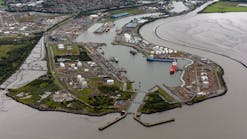Normally, says the firm, these problems would not have been detected until construction was well under way, necessitating expensive design changes and fabrication rework.
Interference checking of the 3D model found interferences with cable trays, angle bracketing, knee bracketing, and structural supports that could not be detected in the 2D visual checks.
These problems were easily resolved in the modeling stage so that the orthographics drawings were corrected before material fabrication and construction. This, says the company, eliminated the staff-hours that would otherwise have been required to revise the drawings, refabricate and reroute piping, and provide additional supports.
Inelectra, the largest engineering firm in Venezuela, specializes in designing and building installations related to petroleum refineries and petrochemical complexes.
Upgrade
The company says it has long used AutoCAD as a 2D design tool. A steady increase over the last several years in the complexity of the work taken on by the firm spurred it to decide to upgrade to 3D design.After investigating a variety of different add-ons to AutoCAD that provided automated 3D piping design, the company selected AutoPLANT computer-aided plant design software from Rebis, Walnut Creek, Calif.
The selection team felt that this PC-based software package offered the modeling and database capabilities of high-end, workstation-based packages at a lower cost.
The first project on which the new software was used was a gas-separation unit used to produce the raw materials for manufacturing olefins.
The plant (Fig. 1 [25,947 bytes]) had to be built within very tight space constraints.
It has 72 pieces of equipment, including heat exchangers, air coolers, and separation columns, and 250 lines. The allotted footprint, however, consisted of a rectangle approximately 120 m by 50 m. As a result, equipment and lines in the 700-ISO plant laid out in a way which greatly increased the difficulty of avoiding interferences in the design.
Working in 3D on this project provided several major advantages, says Inelectra. Rather than simply entering elevation data on the drawing as before, elevations became an integral part of the drawing.
The drawing could be viewed from the front or at any other angle to check clearances and fits. At an early stage, the designers were able to detect problems which would probably not become apparent until the quality control or even the construction phase.
The photorealistic nature of the model (Fig. 2 [27,986 bytes]) made it seem as if the operator were walking through the plant. Escapeways and accessibility of various areas were easily viewed.
The 3D model was run through the interference-detection module purchased with AutoPLANT. Not a single major interference was detected during construction.
This eliminated the need to rearrange or redesign during the installation phase when changes cost perhaps 10 times more than in the early design phase. Working in 2D on a project of this magnitude, says Inelectra, designers are pleased if they can hold field changes to single digits.
Components were automatically placed from a specification, which means that it was virtually impossible to put a 150-psi flange in a 300-psi line. A single specification was assigned to each line so that the only components that could be placed on the line were those assigned to that specification.
The program also provided the ability to run consistency and connectivity checks. Other disciplines were also able to use the model to eliminate errors. Company designers decided on this first project not to make any substantial modifications to the program's standard symbol library, although they modified the drawing format.
Producing ISOs
A major advantage of the new approach is that, once the 3D layout is completed, the section layouts and isometric drawings could be produced much faster than before. All that was required was to define the entities which make up the line and the desired view.Producing isometrics was done automatically by a batch process that let the user specify the line numbers that were to be extracted. When design changes inevitably occurred, they were entered in the 3D model and automatically rippled through the orthographic drawings and related isometrics the next time they were extracted from the 3D model.
The program AutoPLANT ELECTRICS was also used to speed up the design process. For example, it made the process of inserting typical symbols used in the electrical engineering fields into a semiautomatic one because the program answered most intermediate prompts thereby reducing user input and improving consistency. The designer had the opportunity to override these prompts.
Also, to insert a previously created symbol and break the underlying line took 12 steps using basic AutoCAD; a new generation program would typically reduce this to 2 steps.
The wiring schedule tracked wiring connections at each device, device tag, and terminal number. The program automatically kept track of relay coils and contacts and allowed this information to be used in producing grid cross referencing and also kept track of connections between devices for wire numbering.
The wiring report listed wire number, wire size, wire color, and actual device tag and the terminal to which each wire connected. This made it possible for a technician to wire a control panel directly from a schematic.
The program is also capable, says Inelectra, of creating a list of all field cable interconnections by wire number, source, and destination termination which can be exported to the cable schedule database.
Database link
AutoPLANT's link to a text database provided equally significant time savings. Designers were freed from the need to enter descriptions on the drawings. Instead, a secretary typed the specifications for each component into a simple flat-file textual database.After this initial information was input, only modifications needed to be entered into the database. Whenever a symbol is entered into the drawing, the textual information is automatically linked to the drawing.
This information was then used in reports, such as the bill of materials, valve and specialty lists, instrument lists, and line designation schedules. If an error was discovered in a specification, it was corrected simply by typing the correct data into the database. The change was automatically updated, throughout all drawings.
The specifications database was transferred by means of an ASCII file to Inelectra's SIGCROM material-control system. This interface made it possible automatically to produce all necessary requisitions and purchase orders for the project.
Inelectra says another major advantage of building the 3D model is that it gave the client a chance to participate in the design process. Autodesk's 3D Studio program was used to render views of the model for customer presentations.
Inelectra designers were able to show the client how the plant would look, and they suggested changes in spacing which they would otherwise not have been able to visualize until after the plant was built. At this point, making the changes would have been prohibitively expensive.
Inelectra notes that current payment arrangements involve progress billings according to completion of ISOs which made sense when ISOs were integral to the design process.
Now, with the bulk of the time spent building the 3D model and the ISOs being generated all at once at the end of the project, says the firm, a new billing model needs to be developed that is based on progress in completing the model.
Inelectra designers took about 6 weeks to be trained on the project in 3D. Despite this resulting late start, the project was finished on time. Inelectra designers estimate future projects will require about 20% less time.
Copyright 1997 Oil & Gas Journal. All Rights Reserved.


